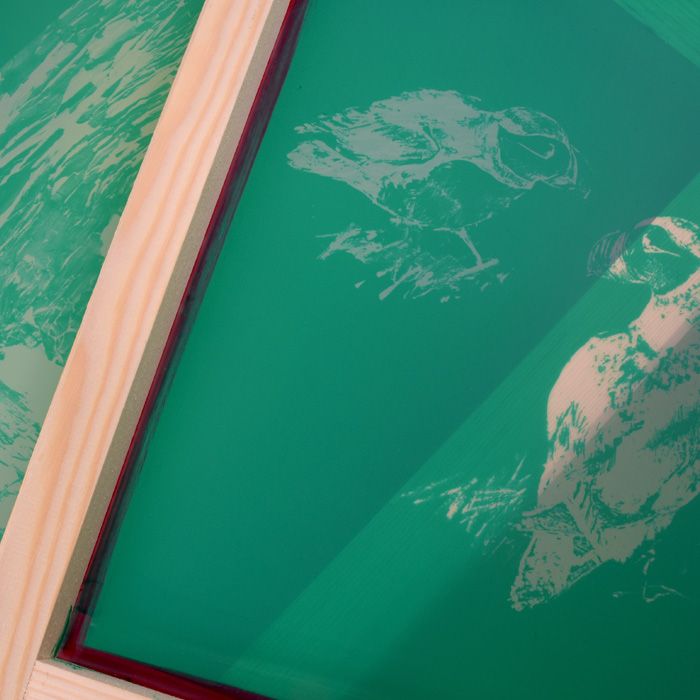Affordable Screen Printing Kit for Home Use
Wiki Article
Screen Printing Uncovered: Whatever You Required to Learn About Tee Shirt and Garment Printing Techniques
If you have actually ever before asked yourself just how those vibrant designs finish up on your favored tees, you remain in the appropriate area. Display printing is a remarkable method that integrates art with method, supplying unlimited possibilities for imagination. Recognizing the fundamentals, from devices to ink choices, can greatly affect your results. Prepared to discover the important aspects that make screen publishing an art form? Allow's uncover the information that can raise your jobs.
The Essentials of Display Printing: How It Functions
When you plunge right into display printing, you'll discover it's both a scientific research and an art. At its core, screen printing entails producing a stencil, or display, that allows ink to travel through just in particular areas (screen printing kit). You begin by selecting your design and preparing your display with a light-sensitive emulsion. As soon as you reveal this emulsion to light, it hardens, leaving your style as an unfavorable space.Placement the display over the fabric, then utilize a squeegee to push ink with the screen onto the garment. Each action is crucial, and understanding them will certainly elevate your screen printing abilities, changing easy garments into unique, meaningful items.
Sorts Of Screen Printing Techniques
As soon as you grasp the essentials of display printing, it's time to discover the various methods that can boost your designs. One popular approach is traditional display printing, where ink is pushed with a stenciled display.An additional alternative is plastisol printing, understood for its sturdiness and dazzling shades, making it a favorite for many brands. Experiment with halftone printing to produce slope effects and elaborate layouts.
Essential Tools for Screen Printing
To achieve spectacular outcomes in display printing, having the right devices is fundamental. You'll require a durable screen printing structure, which holds the mesh that moves your design onto the garment. Next, invest in high-grade mops; these are vital for using ink evenly across the screen.Choosing the Right Inks and Materials
When choosing inks and materials for display printing, you need to take into account the kind of ink that functions best for your project. Assume about textile compatibility to ensure your styles look great and last lengthy. Discover eco-friendly ink options to make your printing procedure much more sustainable.Kinds of Screen Inks
Picking the appropriate screen ink is essential for achieving vivid, long lasting prints that satisfy your task's requirements. There are several kinds of screen inks to check out. Specialty inks, such as glow-in-the-dark or metallic, can add unique results to your styles.
Fabric Compatibility Factors To Consider
Comprehending fabric compatibility is essential for achieving top notch screen prints, especially since different products react distinctively to different inks. Constantly check your inks on sample fabric to ensure they adhere properly and preserve shade stability. Additionally, keep in mind that textile weight and appearance can impact the final result, so choosing the best ink and material combination is crucial for your project's success.Eco-Friendly Ink Options
Eco-friendly inks are becoming a preferred option for display printers who intend to decrease their environmental effect while preserving high quality. When picking inks, think about water-based inks, which are much less unsafe and simpler to tidy up contrasted to conventional solvents. These inks bond well with fabrics, supplying vibrant results without hazardous chemicals. You could likewise discover eco-solvent inks that use fewer unstable natural substances (VOCs), making them a more secure alternative for both your wellness and the planet.Additionally, look for inks made from renewable energies, such as soy or vegetable-based choices. By choosing the best inks and materials, you'll not just create spectacular designs but also add to a much more sustainable printing process. Make the switch, and your prints will mirror your dedication to the atmosphere!
Preparing Your Design for Display Printing

silk screen printing
Submit Layout Needs
To guarantee your layout looks sharp and vivid on material, you'll require to pay close attention to submit format demands for screen printing. Make sure your layout has a transparent history to avoid undesirable white edges on your prints. Maintain color settings in mind; CMYK is typical for screen printing, so transform your RGB develops accordingly.Shade Splitting Up Methods
Color splitting up is a vital step in preparing your design for screen printing, and mastering it can considerably improve your print top quality. You'll require to damage your layout right into specific shades, as each shade needs a separate screen during printing. This precision not only guarantees accurate color representation however additionally simplifies the printing process.Resolution and Dimension
Achieving the most effective cause display printing begins with guaranteeing your style has the appropriate resolution and dimension. Preferably, your art work should be at least 300 DPI (dots per inch) for sharp, clear prints. Your last item might look pixelated and unprofessional. if you make use of lower resolution.When it involves dimension, think about the dimensions of your print location. Layout your artwork to match the last print dimension, ideally developing it in the actual dimensions you'll be publishing. In this manner, you'll prevent any type of unexpected scaling issues.
Constantly inspect your design in both vector and raster formats. Vector graphics can be scaled without losing quality, making them perfect for display printing. Preparing properly will assure your layout looks incredible on every garment!
Step-by-Step Screen Printing Refine
Screen printing is a vibrant process that permits you to produce vibrant designs on numerous surface areas. To get begun, you'll need a display, solution, and your chosen ink.After rinsing the unexposed solution, your screen is ready. Establish it up on your printing surface and align your garment underneath it. Put ink onto the display and make use of a squeegee to press the ink through the stencil onto the fabric. Lift the display thoroughly and let the print completely dry. Treat the ink utilizing warm to ensure toughness. That's it! You have actually successfully screen printed your style.
Tips for Successful Screen Printing Projects
While you're diving into your screen printing projects, bear in mind that preparation is key to success. Start by gathering all your products-- inks, displays, garments, and squeegees. A tidy work area aids prevent undesirable errors, so clean up prior to you begin.Following, confirm your artwork is high-resolution and effectively sized for your garment. Examine your display for proper direct exposure and clean it thoroughly to avoid spots. When mixing your inks, comply with the producer's guidelines to attain the best consistency.
Throughout printing, apply also stress with your squeegee for constant outcomes. Don't rush; take your time to validate each print fulfills your criteria. After printing, let your garments completely dry totally before dealing with or packaging them.
Finally, always maintain a sample of your job for future referral. This means, you can evaluate your development and improve your methods in time. Satisfied printing!

Often Asked Inquiries
The length of time Does It Require To Set up a Screen Printing Task?
Setting up a screen printing work typically takes about half an hour to an hour. You'll prepare the screens, mix inks, and readjust journalism. The moment differs based on complexity and experience, so stay organized!Can I Print on Various Textile Keys In Making Use Of the Exact Same Technique?
Yes, you can print on different fabric types utilizing the exact same technique, but you'll require to adjust your settings and inks. Some materials take in ink in a different way, so experimenting guarantees the ideal outcomes for every material.What Prevail Mistakes to Prevent in Screen Printing?
When display printing, stay clear of typical mistakes like using the incorrect ink, ignoring appropriate direct exposure times, or skipping pre-press checks. Constantly check your arrangement and keep tidy screens to assure high quality outcomes each time.Exactly How Can I Properly Clean and Maintain My Screen Printing Tools?
To appropriately tidy and keep your screen printing tools, you must consistently clean screens with suitable solvents, check squeegees for wear, and guarantee all devices are saved completely dry and dust-free. Uniformity improves and protects against pricey repair work efficiency.Is Display Printing Environmentally Pleasant Contrasted to Various Other Methods?
Screen printing can be much more ecologically friendly than other methods, particularly if you make use of eco-conscious materials and water-based inks. By picking lasting materials and practices, you minimize waste and minimize your influence on the earth.Screen Printing Uncovered: Whatever You Required to Know Regarding T-Shirt and Garment Printing Strategies
At its core, display printing entails producing a stencil, or display, that permits ink to pass with only in particular areas. Setting the display over the material, then make use of a squeegee to push ink with the display onto the garment. One prominent technique is traditional display printing, where ink is pushed through a stenciled screen.When picking inks and products for screen printing, you need to take into account the type of ink that works ideal for your project.
Report this wiki page